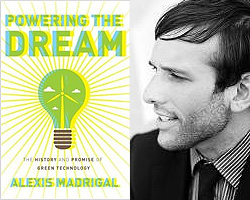 This is the fifth and final post in a series from my conversation with Atlantic tech channel editor Alexis Madrigal about themes and stories from his new book, Powering the Dream: The History and Promise of Green Technology.
This is the fifth and final post in a series from my conversation with Atlantic tech channel editor Alexis Madrigal about themes and stories from his new book, Powering the Dream: The History and Promise of Green Technology.
DR: How should the lessons from your book alter the strategies of technologists and policymakers? How can they exploit these lessons?
AM: I hate to jump on the innovation and jobs train — I have my doubts about it — but purely from a political point of view, we have a lot of the strengths we need to build strong green technology industries here in the United States.
 This endangered desert tortoise may thwart solar power in the Mojave.Photo: Fool-On-The-HillI also think — and this may be a more controversial suggestion — that it might be worth trading some of the landmark ’60s environmental legislation for stronger support for green technology. The way the Endangered Species Act works right now is sometimes counterproductive. It rests on this odd structure of one animal standing in for whole ecosystems, at a local level, preventing changes we might need to prevent global-scale environmental change.
This endangered desert tortoise may thwart solar power in the Mojave.Photo: Fool-On-The-HillI also think — and this may be a more controversial suggestion — that it might be worth trading some of the landmark ’60s environmental legislation for stronger support for green technology. The way the Endangered Species Act works right now is sometimes counterproductive. It rests on this odd structure of one animal standing in for whole ecosystems, at a local level, preventing changes we might need to prevent global-scale environmental change.
I know we both have our fears about, if we were to do this, whether the Democrats would give away the Endangered Species Act and not get anything in return.
DR: That would be in keeping with their recent strategery.
AM: Assuming you had someone who truly could cut a deal for, basically, nuclear-R&D-from-1950-to-1975-style support from the government, that seems to me like it would be a worthy trade. Given what it looks like in Congress right now, if we want to make a big move on green technology, something big has got to change. I don’t think support for nuclear power and offshore drilling are going to get it done, obviously.
DR: People inside environmental groups will tell you privately that there are lots of flaws in the Clean Air Act, the Clean Water Act, and the Endangered Species Act. There are ways you could rationalize them to get better economic and environmental outcomes. But what they’ll tell you is, there’s no rational negotiating partner across the table. Every time they crack the door even slightly, the Huns come invading and try to burn the whole thing down. They can’t let their guard down at all. It’s a dysfunctional situation, going back 30 years now.
AM: In the long term, my hope is in the fact that renewable energy’s strongest places are outside of the cities. The fact that wind energy is so strong in Texas and Iowa, through the whole Midwest, that might start to shift the way those areas think about their interests. If you look at the national political scene, the Southwest is a key place going forward, and that’s where solar would go.
 Maps of U.S. wind and solar power potential.NREL
Maps of U.S. wind and solar power potential.NREL
We’re talking decadal time scales now, but just as West Virginia votes for coal interests, it’s not out of the question — and in fact sort of makes sense — that eventually those Southwestern and Midwestern states will want wind and solar. It’s going to be great for their economies.



